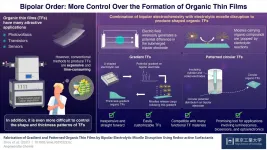(Press-News.org) The combination of a carb-heavy diet and poor oral hygiene can leave children with early childhood caries (ECC), a severe form of dental decay that can have a lasting impact on their oral and overall health.
A few years ago, scientists from Penn's School of Dental Medicine found that the dental plaque that gives rise to ECC is composed of both a bacterial species, Streptococcus mutans, and a fungus, Candida albicans. The two form a sticky symbiosis, known scientifically as a biofilm, that becomes extremely virulent and difficult to displace from the tooth surface.
Now, a new study from the group offers a strategy for disrupting this biofilm by targeting the yeast-bacterial interactions that make ECC plaques so intractable. In contrast to some current treatments for ECC, which use antimicrobial agents that can have off-target effects, potentially harming healthy tissues, this treatment uses an enzyme specific to the bonds that exist between microbes.
"We thought this could be a new way of approaching the problem of ECCs that would intervene in the synergistic interaction between bacteria and yeast," says Geelsu Hwang, an assistant professor in Penn Dental Medicine and senior author on the study, published in the journal mBio. "This offers us another tool for disrupting this virulent biofilm."
The work builds off findings from a 2017 paper by Hwang and colleagues, including Hyun (Michel) Koo of Penn Dental Medicine, which found that molecules call mannans on the Candida cell wall bound tightly to an enzyme secreted by S. mutans, glycosyltransferases (Gftb). In addition to facilitating the cross-kingdom binding, Gftb also contributes to the stubbornness of dental biofilms by manufacturing gluelike polymers called glucans in the presence of sugars.
While some cases of ECC are treated with drugs that kill the microbes directly, potentially reducing the number of pathogens in the mouth, this doesn't always effectively break down the biofilm and can have off-target effects on "good" microbes as well as the soft tissues in the oral cavity.
Hwang and colleagues wanted to try a different approach that would directly target the insidious interaction between yeast and bacteria and opted to target the mannans in the Candida cell surface as a point of contact.
Using three different mannan-degrading enzymes, they applied each to a biofilm growing on a tooth-like surface in a human saliva medium and left it for five minutes. Following the treatment, they noted that the overall biofilm volume was reduced. Using powerful microscopy, they also observed drastic reductions in the biofilm thickness and interactions between bacteria and yeast. The pH of the surrounding medium was higher when exposed to the enzymes, indicating an environment that is not as acidic and thus less conducive to tooth decay.
They also measured how easy it was to break up the biofilm after treatment, using a device that applies a stress, akin to tooth brushing.
"The biofilm structure was more fragile after the enzyme treatment," Hwang says. "We were able to see that the biofilms were more easily removed."
To confirm the mechanism of their approach--that the mannan-degrading enzymes were weakening the binding between yeast and bacteria--the team used atomic-force microscopy to measure the bonds between Candida and Gftb. The therapy, they found, reduced this binding force by 15-fold.
Finally, they wanted to get a sense of how well-tolerated these enzymes would be when used in the oral cavity, especially since children would be the patient group targeted.
Applying the enzymes to human gingival cells in culture, they found no harmful impact, even when they used a concentrated form of the enzymes. In addition, they observed that the treatment didn't kill the bacteria or yeast, a sign that it could work even if the microbes developed mutations that would lend them resistance against other types of therapies.
The researchers kept the application time relatively short at five minutes though they hope to see activity in an even shorter time, like the two minutes that is recommended for tooth brushing. Hwang says they may consider a non-alcohol-based mouthwash with these enzymes added that could be used by children as a preventive measure against ECC.
The researchers hope to continue pursuing this possibility with additional follow up, including testing these enzymes in an animal model. With more successes, they aim to add another tool for fighting the public health threat of ECC.
INFORMATION:
Geelsu Hwang is an assistant professor in the Department of Preventive and Restorative Sciences in the University of Pennsylvania School of Dental Medicine.
Hwang's coauthors were Hye-Eun Kim, Atul Dhall, Yuan Liu, Marwa Mohammed Barwazir, and Hyun (Michel) Koo of Penn's School of Dental Medicine.
The study was supported in part by the National Institutes for Dental and Craniofacial Research (grants DE027970 and DE025220) and Josephine and Joseph Rabinowitz Award.
In studying COVID-19 testing and positivity rates in West Virginia between March and September 2020, West Virginia University researchers found disparities among Black residents and residents experiencing food insecurity.
Specifically, the researchers found communities with a higher Black population had testing rates six times lower than the state average, which they argue could potentially obscure prevalence estimates. They also found that areas associated with food insecurity had higher levels of testing and a higher rate of positivity.
"This could mean that public health officials are targeting predominately rural areas to keep tabs on how the pandemic will unfold in isolated communities within higher food insecurity," said Brian Hendricks, a research assistant professor with ...
Australian scientists have compared an ancient Greek technique of memorising data to an even older technique from Aboriginal culture, using students in a rural medical school.
The study found that students using a technique called memory palace in which students memorised facts by placinthem into a memory blueprint of the childhood home, allowing them to revisit certain rooms to recapture that data. Another group of students were taught a technique developed by Australian Aboriginal people over more than 50,000 years of living in a custodial relationship with the Australian land.
The ...
Researchers at Michigan Medicine found that people with venom allergies are much more likely to suffer mastocytosis, a bone marrow disorder that causes higher risk of fatal reactions.
The team of allergists examined approximately 27 million United States patients through an insurance database - easily becoming the nation's largest study of allergies to bee and wasp stings, or hymenoptera venom. The results, published in the Journal of Allergy and Clinical Immunology, revealed mastocytosis in fewer than 0.1% of venom allergy patients - still near 10 times higher than those without allergies.
"Even though there is mounting interest, mast cell diseases are quite understudied; ...
Modern and emerging applications in various fields have found creative uses for organic thin films (TFs); some prominent examples include sensors, photovoltaic systems, transistors, and optoelectronics. However, the methods currently available for producing TFs, such as chemical vapor deposition, are expensive and time-consuming, and often require highly controlled conditions. As one would expect, making TFs with specific shapes or thickness distributions is even more challenging. Because unlocking this customizability could spur advances in many sophisticated applications, researchers are actively exploring new approaches for ...
In quiet moments, the brain likes to wander—to the events of tomorrow, an unpaid bill, an upcoming vacation.
Despite little external stimulation in these instances, a part of the brain called the default mode network (DMN) is hard at work. "These regions seem to be active when people aren't asked to do anything in particular, as opposed to being asked to do something cognitively," says Penn neuroscientist Joseph Kable.
Though the field has long suspected that this neural network plays a role in imagining the future, precisely how it works hadn't been fully understood. Now, research from Kable and two former graduate students in his lab, Trishala Parthasarathi, associate director of scientific services at OrtleyBio, and Sangil Lee, a postdoc at University of California, ...
SAN DIEGO (May TK, 2021) - Compared to most other bear species, very little is known about how female Andean bears choose where they give birth to cubs. As a critical component of the reproductive cycle, birthing dens are essential to the survival of South America's only bear species, listed as Vulnerable on the International Union for Conservation of Nature (IUCN) Red List of Threatened Species.
A new study led by Russ Van Horn, Ph.D., published April in the journal Ursus, takes the most detailed look yet at the dens of this species. Van Horn, a population sustainability scientist, leads San Diego Zoo Wildlife Alliance's Andean bear conservation program. He was joined by colleagues from the University of British Columbia's Department of Forest ...
A large survey of women in California shows significant racial and ethnic differences in the types of personal care products women use on a daily basis. Because many personal care products contain endocrine disrupting chemicals (EDCs) like parabens and phthalates that interfere with the body's hormones, the findings could shed light on how different products influence women's exposures to harmful chemicals that contribute to health inequities.
The study appears in the Journal of Exposure Science & Environmental Epidemiology as part of a special issue focused on health equity. ...
In the midst of a devastating global pandemic of wildlife origin and with future spillovers imminent as humans continue to come into closer contact with wildlife, infectious-disease models that consider the full ecological and anthropological contexts of disease transmission are critical to the health of all life. Existing models are limited in their ability to predict disease emergence, since they rarely consider the dynamics of the hosts and ecosystems from which pandemics emerge.
Published May 17 in Nature Ecology and Evolution, Smithsonian scientists and partners provide a framework for a new approach to modeling infectious diseases. It adapts established methods developed to study the planet's natural systems, including ...
LA JOLLA--(MAY 18, 2021) Despite only accounting for about 1 percent of skin cancers, melanoma causes the majority of skin cancer-related deaths. While treatments for this serious disease do exist, these drugs can vary in effectiveness depending on the individual.
A Salk study published on May 18, 2021, in the journal Cell Reports reveals new insights about a protein called CRTC3, a genetic switch that could potentially be targeted to develop new treatments for melanoma by keeping the switch turned off.
"We've been able to correlate the activity of this genetic switch to melanin production and cancer," says Salk study ...
Nearly 15 percent of the U.S. population experiences migraine. One subtype of migraine that is not well understood is migraine with aura (MA). Individuals who experience MA often see flashing lights, blind spots, or jagged lines in their visual field prior to onset of their migraine headaches. Individuals who experience MA also face a heightened risk of stroke and cardiovascular disease, although scientists continue to explore why this correlation exists. In a new study from Brigham and Women's Hospital, researchers used a technique in genetic analysis termed Mendelian randomization to examine 12 coagulation measures, uncovering four that are associated ...


